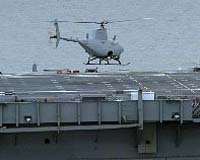| . |  |
. |
Cape Canaveral FL (SPX) Mar 07, 2011 Boeing has announced the successful launch of the second Boeing-built X-37B Orbital Test Vehicle (OTV) for the U.S. Air Force Rapid Capabilities Office (RCO). The OTV was launched on an Atlas V rocket into a low-Earth orbit today at 5:46 p.m. Eastern time from Cape Canaveral Launch Complex 41. "History was made in December when the X-37B became the United States' first unmanned vehicle to return from space and land on its own," said Craig Cooning, vice president and general manager of Boeing Space and Intelligence Systems. "The success of that mission validated this reusable and effective way to test new technologies in space and return them for examination. "today, we took another important step with the successful launch of the second OTV, enabling the RCO to further experiment with the vehicle and its ability to operate in low-Earth orbit," Cooning continued. "Close teamwork between the Air Force Rapid Capabilities Office, the United Launch Alliance Atlas team, and the 45th Space Wing at Cape Canaveral Air Force Station made this launch a success." The first OTV was launched in April 2010 and orbited for approximately eight months. In December, it successfully de-orbited and landed at Vandenberg Air Force Base, Calif., where it continues to undergo post-flight evaluation. The X-37B design combines the best of aircraft and spacecraft design into an affordable, unmanned space-based test platform. Program objectives include space experimentation, risk reduction, and concept-of-operations development for reusable space vehicle technologies. Boeing's commitment to this space-based unmanned vehicle spans a decade and includes support to the Air Force Research Lab's X-40 program, NASA's X-37 program, and the Defense Advanced Research Projects Agency's X-37 Approach, Landing and Test Vehicle program. Boeing program management, engineering, test and mission support functions for the OTV program are conducted at Boeing sites in Huntington Beach, Seal Beach, and El Segundo, Calif.
related report The mission was launched from Cape Canaveral Air Force Station, Fla., by a United Launch Alliance Atlas V rocket. The Atlas V is powered by the RD AMROSS RD-180 booster engine and a Pratt and Whitney Rocketdyne RL10 upper-stage engine. Pratt and Whitney Rocketdyne is a United Technologies Corp. (NYSE: UTX) company. RD AMROSS LLC is a joint venture of Pratt and Whitney Rocketdyne and NPO Energomash. "Pratt and Whitney Rocketdyne is pleased to be part of such an important mission by providing power for the U.S. military," said Jim Maus, director, expendable propulsion programs, Pratt and Whitney Rocketdyne. "This is the RL10's 48th year of flight, and as the world's first liquid-hydrogen fueled rocket engine, we're proud to see it continue its legacy as one of the nation's most reliable upper-stage engines." "RD AMROSS congratulates the U.S. Air Force and United Launch Alliance on another successful launch," said Tom Wonnell, president and CEO of RD AMROSS. "We look forward to working together to ensure future successful missions." The X-37B is one of the world's newest and most advanced re-entry spacecraft, designed to operate in low-earth orbit, 110 to 500 miles above the Earth at speeds of about 17,500 miles per hour. The vehicle is the first since the space shuttle with the ability to return experiments to Earth for further inspection and analysis. The Atlas V Centaur upper stage is powered by a single RL10A4-2 engine that delivers 22,300 pounds of thrust. The Atlas V Common Core booster is powered by the RD-180 engine and delivers nearly 1 million pounds of thrust. The RD-180 is the only liquid oxygen-kerosene fueled engine with an oxygen-rich staged combustion cycle flying in the United States today.
Share This Article With Planet Earth
Related Links Pratt and Whitney Rocketdyne UAV News - Suppliers and Technology
 Fire Scout Completes First Unmanned Test Flights On Littoral Combat Ship
Fire Scout Completes First Unmanned Test Flights On Littoral Combat ShipSan Diego CA (SPX) Feb 25, 2011 The Northrop Grumman-built MQ-8B Fire Scout vertical takeoff and landing tactical unmanned aerial vehicle (VTUAV) achieved a significant development milestone in November when it flew its first test flights from the U.S. Navy's littoral combat ship, USS Freedom (LCS-1). The Navy conducted the activity, known as dynamic interface (DI) testing, off the coast of southern California to verify ... read more |
|
| The content herein, unless otherwise known to be public domain, are Copyright 1995-2010 - SpaceDaily. AFP and UPI Wire Stories are copyright Agence France-Presse and United Press International. ESA Portal Reports are copyright European Space Agency. All NASA sourced material is public domain. Additional copyrights may apply in whole or part to other bona fide parties. Advertising does not imply endorsement,agreement or approval of any opinions, statements or information provided by SpaceDaily on any Web page published or hosted by SpaceDaily. Privacy Statement |